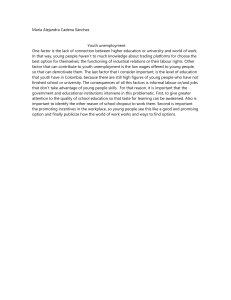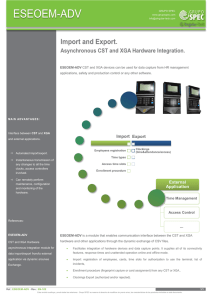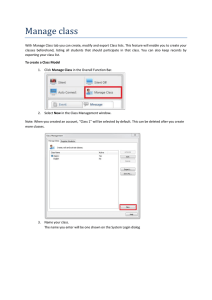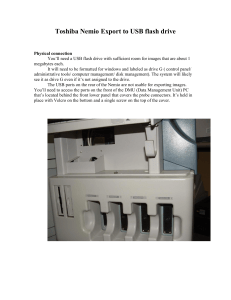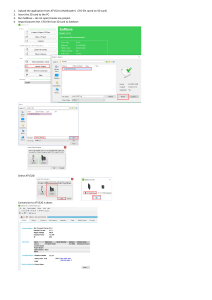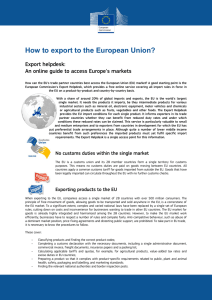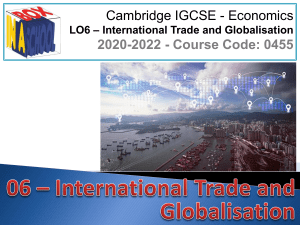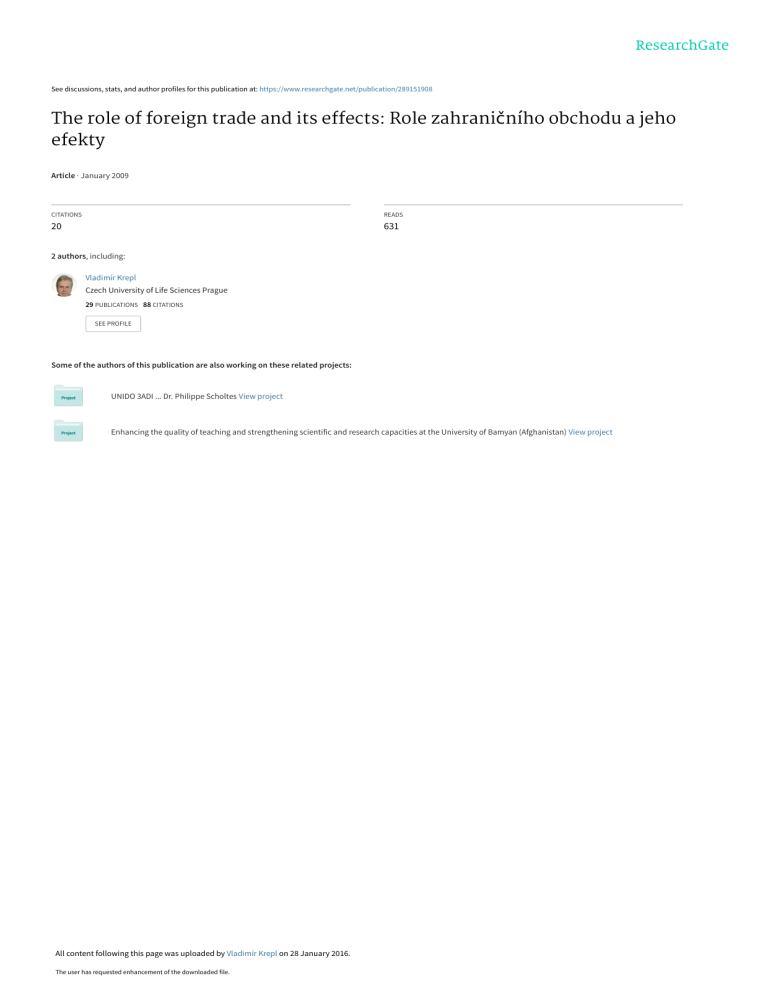
See discussions, stats, and author profiles for this publication at: https://www.researchgate.net/publication/289151908 The role of foreign trade and its effects: Role zahraničního obchodu a jeho efekty Article · January 2009 CITATIONS READS 20 631 2 authors, including: Vladimír Krepl Czech University of Life Sciences Prague 29 PUBLICATIONS 88 CITATIONS SEE PROFILE Some of the authors of this publication are also working on these related projects: UNIDO 3ADI ... Dr. Philippe Scholtes View project Enhancing the quality of teaching and strengthening scientific and research capacities at the University of Bamyan (Afghanistan) View project All content following this page was uploaded by Vladimír Krepl on 28 January 2016. The user has requested enhancement of the downloaded file. The role of foreign trade and its effects Role zahraničního obchodu a jeho efekty V. Jeníček, V. Krepl Faculty of International Relations, University of Economics, Prague, Czech Republic Abstract: Foreign trade is the reflection of economic relationships among the individual economies and represents the part of the country foreign relationships, which include trade exchange of a part of the production. In the simplifies balance understanding, it is usually presupposed that the object of this exchange is such a part of the production, which exceeds the home consumers demand and thus is the object of export, or, vice versa, that part of the home demand which is not satisfied by the home production and thus has to be covered by import. In reality, the whole process is, however, substantially more complicated, as the whole series of reasons (price, trade, political etc.) lead often to exporting even those products which might have been realised in the home market, regarding the purchasable demand, and on the other hand, import includes in most commodity groups also the products competing with the home production and thus securing a wider assortment of supply. Key words: function of foreign trade, transformation function, factor of economic growth, factor of the home economy lagging behind, measure and shape of the economy openness, evaluation of the foreign trade effects Abstrakt: Zahraniční obchod je projevem ekonomických vztahů mezi jednotlivými ekonomikami a představuje tu část zahraničních vztahů země, která zahrnuje obchodní směnu části produkce. Ve zjednodušeném bilančním pojetí se zpravidla předpokládá, že předmětem směny je ta část produkce, která převyšuje domácí spotřební poptávku, je tedy předmětem exportu; nebo je to naopak ta část domácí poptávky, která není uspokojena tuzemskou produkcí, a proto musí být doplněna importem. Ve skutečnosti je ovšem celý proces podstatně složitější, protože celá řada důvodů (cenových, obchodních, politických apod.) vede často k vývozu i těch produktů, které by bylo možné vzhledem k úrovni koupěschopné poptávky realizovat na domácím trhu, a naopak dovoz zahrnuje u většiny produktů i výrobky konkurující domácím výrobkům; zajišťuje tak pestřejší sortiment nabídky. Klíčová slova: funkce zahraničního obchodu, transformační funkce, faktor ekonomického růstu, faktor zaostávání domácí ekonomiky, míra a tvar otevřenosti ekonomiky, hodnocení efektů zahraničního obchodu FUNCTION OF FOREIGN TRADE Foreign trade is historically the oldest and still important part of the external economic relationships. Their impact on the economic development of the individual countries has deepened considerably namely during the whole period after the WW2, in the last decades the international trade development belongs among the most dynamic elements of the world economy development. At that, it represents not only the dynamic development on the quantitative level, but also, from the viewpoint of the struc- tural changes of the individual countries, also the complex international trade flows. In harmony with the conclusions of the classical, neo-classical as well as modern foreign trade theories, it can be stated that at present foreign trade belongs to the decisive factors influencing economic growth of both the individual countries as well as the world economy (Jeníček 2003). Looking at the functioning of foreign trade in the economy of the individual countries, we can find considerable differences in the dependence on the type of economy regarding its economic size and the level Supported by the Ministry of Education, Youth and Sports of the Czech Republic (Project No. MSM 6138439909). Agric. Econ. – Czech, 55, 2009 (5): 211–220 211 of economic development. Nevertheless, it is possible to mark certain functions as generally valid: – Transformation function, i.e. the influence of foreign trade on forming the internal economic balance level – Growth function, i.e. fulfilling the viewpoint of the “economy of time“ with the result of saving national labour by taking part in the international division of labour – Foreign trade can, under certain conditions, act as a barrier of the home economy growth – Mutual interaction between the growth (or decline) of national income and the growth (decline) of export. TRANSFORMATION FUNCTION The transformation impact of foreign trade represents historically the primary meaning of the economic relationships with abroad. Foreign trade changes (transforms) the structure of national production, resp. of national resources, into the demanded structure in the sphere of use (intermediate as well as final). The transformation function of foreign trade is especially pronounced in the relatively small economies where the import flows are the prerequisite of overcoming the limits in production resources, respectively the efficiency of their use (with regard to the internal market scope). Therefore, it is possible to correct through import of certain products the limits given both by the natural conditions (insufficient raw materials resources, limited area, soil and climatic conditions) and the economic conditions (production costs of the home production are relatively high regarding the given scope of the home market). Transformation impact of foreign trade is of growing importance also with regard to the increasing economic level of the country, which brings about a considerable growth of the differentiation of needs. At the same time, a more developed economy is characteristic by the production specialisation growth, that is by the efficient narrowing of the produced assortment, what at the simultaneous widening of the consumption assortment asks necessarily for the increased import (in this sense, import is understood as the manifestation of the other pole of specialisation, that is the so-called passive specialisation). The influence of external economic relationships through the transformation of production factors on the international level enables to overcome the home limits in the disponibility of these factors or with regard to a certain time frame. For example, a contemporary use of foreign labour, import of the 212 specialised equipment enabling an accelerated start of the home production means utilisation, the use of foreign credits for extending the home resources in the given period etc. All this means the potential positive impact of foreign trade (resp. external economic relationships) on the fluency of the home reproduction process. Transformation impact of foreign trade in time diversifies its factual content, it still more moves from the exchange of final products to the international exchange of the individual production phases outputs (the shift from the product specialisation to the individual parts specialisation). As a higher type of the transformation impact of external economic relationships on the national economy, there is regarded the so-called transmission function. While the basic transformation function is the tool of the home production and home resources substitution by import of commodities or drawing of the foreign production factors, the transmission function is the tool of the transfer of information, criteria and stimuli from the external environment into the home economy for the utilisation in the home subjects decision-making processes. This transmission function is labelled by some authors as the process of “learning from abroad“ in the widest sense and it is regarded as the most dynamic and important impact of the external economic relationships on the individual countries economy during the last decades of the world economy development. FACTOR OF ECONOMIC GROWTH Further of the general reasons of incorporating the country into the international division of labour through the international foreign trade exchange is reaching savings of the national labour used, in other words, fulfilling the principle of time economy. From the growth effect viewpoint, there is important the structure of the home production and home resources substitution by the import of commodities or the utilisation of foreign resources. Applying the economy of time principle on the international scale is the source of increasing growth rates over the development possibilities in the frame of the isolated national economy. Growth function of foreign trade is connected to forming of the specialisation profile of the economy, and that namely in the relatively small economies, where the structure of home economy is influenced considerably by the export efficiency and competitiveness of the given country products in international markets. Agric. Econ. – Czech, 55, 2009 (5): 211–220 Specialisation profile criteria Searching for answers to the question by what the structure of export and import (in other words, the structure of the active and passive specialisation of the economy) is determined was and is the object of the long-term research of the international trade theory. Let us try to supply in the next part of the contribution a concise survey of the basic approaches. Using a simplified view, we can speak of the following criteria of forming the specialisation profile, as underlined by the individual theoretical approaches: – Differences in the absolute volume of labour costs – Differences in the comparative (relative) labour costs – Differences of the individual countries equipment by the individual production factors (land, labour, capital) – Differences in the reached technology (in relation to the so-called product cycle or product life-cycle) – Differences in the “human capital“, in knowledge (know-how in the widest sense of the word) – Geographical concept of comparative advantages Difference in the absolute costs The principle based on the differences in absolute labour costs was formulated by the classic of the economic theory Adam Smith. According to this theory, the criterion of incorporation of a country into the international division of labour is the difference in the absolute labour costs per unit of production in the individual countries (the principle of absolute advantages for specialisation). Difference in relative costs The principle of absolute advantages was corrected by another English classic of the economic theory – David Ricardo, who replaced the differences in absolute advantages by comparative (relative) advantages issuing from the relatively lower labour costs spent in different countries for production of the compared commodities. A less developed country, which has higher absolute labour costs of all products, will specialise on the production and export of those products where its disadvantage is the least, thus, it has a comparative advantage in producing them. On the other hand, a country, which has the absolutely lowest labour costs at all products, will specialise Agric. Econ. – Czech, 55, 2009 (5): 211–220 at the production and export of those products where its advantage at the absolutely lower costs is relatively the highest. Ricardo considered in his model the reality of the ongoing mutual trade among countries, some of which had no absolute advantage at the production at any of the internationally exchanged products (the trade of less developed countries with the industrially more developed ones). The conclusions of both classics of the economic theory, which formed the core of the so-called net theory of international trade, can be shortly expressed as follows: – All countries profit by incorporation into international trade if the criterions of this incorporation are comparative advantages based on the differences in relative (absolute) labour costs. – The need of the international trade liberalisation is underlined there. Objections from the side of the classical theory of international trade critics: – It is a static approach, it does not take into consideration the possibility of changes of the unit costs level in dependence on the volume of production changes (for example the decrease of unit costs with the increase of production over the home demand level) – It abstracts from the transaction costs which might be decisive in deciding on export or import – It does not consider the size of the country while this factor influences the level of the possible home production specialisation as well as the natural conditions – The starting level of the absolute and relative advantages (based on absolute and relative costs) is the result of the historically different economic level of countries and as such it does not bring equal advantages to the foreign exchange partners – in other words, questioning the reasons for liberalism in trade policy. Differences in equipment with production factors The principle of incorporation into the international division of labour according to the differences in equipment of the country with production factors (land, labour, capital) has been formulated by the neo-classics of the net theory of international trade, Swedish economists Eli Heckscher and Bertil Ohlin (Heckscher 1919). Their theory issues from two prerequisites: 213 – Different products differ during their production by the relative demands for the individual production factors – Individual countries differ with regard to their relative equipment by the individual production factors. Since the price of a production factor depends on the relative abundance or scarcity of the factor in the country, it is obvious (according to this theory) that the production of certain goods will be relatively cheap in the individual countries if there are used for their production the factor in relative abundance in the relevant country. General conclusions of the neo-classics: – The criterion of specialisation is the relative equipment with production factors – Comparative advantage issues from the abundance of the factor – The abundant factor is cheap in the country – Products based on the abundant are cheap Objections from the position of critics to this theory – Abstraction and substitution of factors – Abstracting from the international mobility of factors – International trade causes levelling of the production factors prices. Differences in the level of scientific and technological progress Technological gap After the Swedish neo-classics, there emerged, in connection to the growing impact of technological progress in the world economy, modern theoretical approaches explaining the changes in the structure of international trade by the different procedure of scientific and technological progress in different countries. One of these approaches is the theory of the so-called “technological gap” or the “imitation lag”, connected with the name of the American economist Posner (1961). According to these approaches, a certain new product exported from the country A to the country B keeps comparative advantages only for such a time until the home producer is able to start its home competitive production. 1 The technological gap or imitation lag is given by the time span between the so-called “demand lag” – the period necessary for the origination of home demand for the new product, and the “reaction lag” – the period necessary for the home producer to be able to compete with the substitute home product 1. The theory of the product cycle (product life cycle) A similar approach to the explanation of the foreign (or international) trade structure changes as the technological (or innovation) gap theory is included alsoin the theory of the Product Cycle or the Product Life cycle. Both theories are consistent; both of them see the decisive factor of explaining the international trade structure in the level of the applied technology. The life cycle theory was formulated by the American economist R. Vernon. According to it, an industrial product goes through a certain cycle of its technological (technical) development: at the beginning, it is a top product, then it gradually matures and at last it becomes an under-average or obsolete product. In dependence to the individual phases of the product cycle, an individual producer (or country of production) is in the situation of: – Holder of the greatest comparative advantage (and thus the highest export possibilities), it is the country or producer of the top technological level – In the further procedure of the product cycle, when the product had matured and was managed technologically also by other producers, the originally exceptional comparative advantage for the top country is lost, the commodity is produced and exported by the country (producer) on the medium level of technological development – The further phase of the product cycle is lagging behind, the production is managed by the less developed producers and exported by these technologically under-average producers (countries). The following graph depicts in the upper part the life cycle curve of a certain product sold in the U.S. market, the lower half of the graph then shows the different intensity of foreign trade with the given product in the individual regions according to their technological level reached at the given stage of the product cycle. Posner in his studies invents the indicator of the innovation measure, i.e. the volume of new commodities which the country introduced into the market per the given time unit and the velocity with which the country imitates foreign innovation. The trade among partners with unequal innovation and imitation dynamics was characterised by T. Balogh, that the less dynamic partner becomes the “wood-cutter and water-bearer”. The slower partner makes for the lack of the trade with new commodities by an increased export of traditional (or obsolete) products at reduced prices. 214 Agric. Econ. – Czech, 55, 2009 (5): 211–220 t1 t2 t3 5. Demise 4. Sales decline 3. Maturity 2. Expansion 1. Introduction U.S. sales volume t0 t5 t4 Time Net export of this good (a) X>M Canada, Europe and Japan United States Rest of the world Time M>X Canada, Europe and Japan Rest of the world Canada, Europe and Japan become net exporters United States United States becomes a net importer (b) Figure 1. Product life cycle X = export, M = import Source: According to Wells (1972) For example, the USA as a country of top technology was the exporter in the top period of the product (introduction to the market, expansion). As soon as the product had reached “maturity”, it was managed even by the average technology level countries and the USA decreased export, stopped production, became the importers of the given product (Figure 1). Changes in the international participation in production and trade in connection to the etaps of product life cycle (Table 1). Differences in “human capital” The most modern approaches to the analysis of the international specialisation criteria underline the decisive role of human knowledge, specialised qualification of the highest level as the prerequisite of managing the top technologies. Comparative advantage for incorporation into the international division of labour is derived from the differences in the level of “human capital”; see for example American econoAgric. Econ. – Czech, 55, 2009 (5): 211–220 mist P. Kenen (1989) and others. The conclusions of these theses speak of the highest and most dynamic comparative advantages (so-called “first mover advantages”) from international trade, which are acquired only by those producers (countries) whose “human capital” is of the top level. Some of these authors even speak of the fact that that producer (country) which is the first in the top level of technology has a real possibility to sustain this advance of the highest comparative advantage in the long-term (they argue for example by the example of Japan in the microcomputers production etc.) (Tichá 2008). Geographical concept of the specialisation structure Some of the modern theoretical approaches search for and find the criteria for specialisation and the structure of country incorporation into the international trade in geographical factors, e.g. P. Krugman (1991) underlines the following relationships as the decisive ones: 215 Table 1. Product life cycle etaps Production allocation Market position Introduction Growth (expansion) – in the innovating country (usually industrially developed country) – In innovating country, eventually other industrially developed countries – namely in the innovating country market and beginning of export – namely in industrially developed countries shifts to export in the markets where also foreign production occupies export shares in markets – almost monopolist position – motivation of sales rather uniqueness Factors of competitiveness of product than price – developing characteristics of product – quickly growing demand – growing number of competitors – some competitors start price reduction – product becomes more standard – short-term production cycles – development of technology together with development of product – high demand on qualification in relation to capital demand – growing capital inputs – more standardised procedures Maturity Decline (fall) Production allocation – in many other countries – namely in less developed countries Market position – growth of sales in less developed countries – certain decline of sales in industrial countries – namely in the less developed countries markets – starting exports from less developed countries Production technologies – overall stabilisation of demand – decreasing number of competitors Factors of competitiveness – price decisive namely in less developed countries Production technologies – overall decline of demand – price is the key weapon – number of producers declines – long production cycle with high capital impulses – highly standardised procedures – need of less qualified labour – non-qualified labour and highly – mechanised long production cycle Source: Daniels, Radebangh (1993) – centre and periphery – from these relationships, he derives the model of the geographical concentration (of production and trade) where the decisive point is the efficiency from the transport costs viewpoint – tendency to forming certain industrial locations and to their constancy (in relation to the geographically situated natural resources) – factor of similarity as one of the factors highly influencing the structure of international trade: climatic conditions, national cultural habits, big or small educational differences, political differences religious differences etc. FACTOR OF THE HOME ECONOMY LAGGING BEHIND There also exist theoretical approaches explaining the reasons and conditions under which foreign trade can (even if temporarily), instead of being the 216 potential growth factor, become a brake, a factor of lagging behind or a bottleneck of the economy. The meaning of foreign trade then will, under such a situation, turn into its opposite, the extension of foreign exchange decreases resources and national income instead of increasing them. Protectionist theories From the period of the classical net theory of international trade, we can mention the protectionist theories of the so-called infant industry – H. Carey and namely F. List (1841), which reach the conclusions that if industrial branches of a given country are at the beginning phase of their development, then the country is not able to face foreign competition and free trade thus will mean damaging the home economy. Therefore, the authors reason for protectionism, however, only temporarily, until the time when home industry reaches maturity. Agric. Econ. – Czech, 55, 2009 (5): 211–220 Similar approaches are offered also by the more modern protectionists with regard to developing economies. It is e.g. the theory of the “impoverishing growth” formulated in the mid50s by the renowned Indian economist Jagdish Bhagwati. His theory speaks of the economic decline of less developed countries under the impact of the increasing supply of export commodities in these countries. He sees the reasons of this phenomenon in the following: – the country exports monoculture products or raw materials (its processing industry is not developed on the competitive level) – the supply of these products is strongly inelastic, the supply increases at a considerable price decrease – these products are the only or the most important part of export and when the price decline is so high that it cannot be levelled by a further increase of supply, the economic lagging behind of the country takes place. Similar conclusions were reached also by another theoretician of developing economies, R. Prebish (1956) (beginning of the 60s), who speaks of the specifics of the so-called periphery economy and substantiates the justified demands for protectionism in the international trade regarding developing countries. The following reasons for protectionism in the international trade are given in many theses as commonly accepted: – the example of developed economies is the example of reaching economic development by the way of industrial development – primary products do not supply a sufficient base for development since the world demand for them is inelastic – diversification of production and export is the guarantee of a higher stability of the income growth, at the same time, it decreases the dependence on external environment – the rate of technological development is quicker in industrial production than in the production of primary products – even developing countries have certain potential comparative advantages in some industrial sector. THE MEASURE AND SHAPE OF THE ECONOMY OPENNESS Among the basic characteristics of the level of the economy openness towards its external environment, there belongs usually the share of foreign trade (export, Agric. Econ. – Czech, 55, 2009 (5): 211–220 import, turnover) in the total economic activity of the relevant economic entity. Another characteristics are those expressing the structure of the export and import flows, labelled often as the shape of openness. Besides the quantitative viewpoints of the measure and shape of the economy openness, there is important also the aspect of its efficiency as the expression of the level of the national labour evaluation in the export and import activities. As the indicators of the economy openness to the world level, there are usually used the rates of export, import, turnover to the aggregates of economic activity, i.e. the rate of export, import and turnover to the GDP. To secure a higher comparative level (the question of the inconsistent understanding of GDP, non-consistence of home and world prices), world statistics follow systematically the indicator of per capita export of turnover of foreign trade in USD. The interrelating of national economies with their external environment is of different character at present than it were in past when the foreign trade exchange used be in fact the only form of the external economic relationships. At present, it regards a wide range of two-way flows not only material, financial, credit, labour, but also, with still growing dynamics, of non-material flows: information, learning, technological services, scientific and research results in the form of patents, licences, know-how in the widest sense. Besides the considerable growth of the share of non-material flows, there changes also the character of the commodity foreign trade. From the exchange of final goods, the balance shifts to the exchange of intermediate products as the results of the partial etaps of processing. It means the transition from the vertical to horizontal commodity exchange, from the inter-sectoral to intra-sectoral and even intra-enterprise exchange (parts, knots). Foreign trade thus becomes still more the result of direct specialisation and co-operation in production, but also in the pre-production etaps, research, projects, investments. Empirical analyses done on the world level in a longer time horizon reach the conclusions, that there exist certain general tendencies in the level of the individual countries incorporation into the international decision of labour in dependence to the type of economy. These tendencies can be characterised by the following correlation relationships: – negative correlation between the economic size of the country and the level of openness, i.e. the bigger the economy is, the smaller is its average relative incorporation into the international division of labour and vice versa for small economies 217 – positive correlation between the level of economic development of the country and its level of incorporation into the international division of labour, that is the more developed the economy is, the more intensively it is, at the comparable economic size, incorporated into the international division of labour than the economy of a lower level of economic development. The indicator characterising the level of openness is the per capita export in USD, economic level expressed by per capita GDP for example in relation to the US base. Big economies (over 50 mill. inhabitants) have in average a smaller level of openness than small economies. In both groups, it is possible to follow also the second dependence – the positive correlation of economic development and the measure of openness, even if with certain deviations issuing from the limits of the followed phenomena in time and space. While the evaluation of the level of openness presents a quantitative dimension (even if as the result of the individual decisions on the export and import flows which are already the reflection of a certain qualitative dimension), the analysis of the shape of openness represents necessarily qualitative aspects. There exist different approaches to the analysis of the shape of the economies openness; here, we supply the overview of the utilised methodological approaches: – analysis of the commodity structure of export and import in the internationally comparable classification – evaluation of the transformation performance of economy – evaluation of the development of the export and import prices and the real terms of trade – international comparation of the export per kilogram prices – evaluation of the impact of the technology factor on the export structure – analysis of the export increase by the method of the constant market share. We regard as logical to issue in evaluation of the structure of incorporation into the international division of labour from the principle of comparative advantages (in the sense of its variant manifestation of different theories corresponding to the given etaps of the international economic relations development) and from looking for an answer to the question which potential comparative advantages does the given economy dispose of in a certain period and how they are utilised in the real incorporation into the international division of labour. 218 EVALUATION OF THE FOREIGN TRADE EFFECTS The internationally used indicator for evaluation of the development of foreign trade effect for the national economy is the indicator of the real Terms of Trade (TT), which is most often followed as the statistically ascertained commodity terms of trade given as the rate of the time price index of export to the time price index of import (usually multiplied by 100): ܶܶ ൌ ܲ௫ ܲ where: Pex = price index of export Pim = price index of import. Therefore, the values higher than 1 (eventually 100) express the positive development and vice versa. The economic content of the indicator lays in the possibility to express the change of the purchasing power of export caused by the development of prices in the foreign trade of the given country. For a special use in international statistics, there is sometimes used the expression of the terms of trade between the development of the final products prices on the prices of raw materials and fuels (so-called price scissors). Besides terms of trade as a dynamic non-dimensional indicator, there are theoretically defined (but not systematically followed because of the statistical problems) another two groups of the term of trade indicators: – Income terms of trade expressing the absolute value impact of the commodity terms of trade on the physical volume of export: ܦൌ ܲ௫ ൈ ܳ௫ ܲ where: D = income terms of trade Qex = index of the physical volume of export – Factorial terms of trade which respect, besides the price development, also the productivity of labour development, and that either in the home country of export only (simple) or also abroad (double): ܨൌ ܲ௫ ൈ ܼ௧ ܲ ܨܨൌ ܲ௫ ܼ௧ ൈ ܲ ܼ௭ where: F = simple factorial terms of trade FF = double factorial terms of trade Zt = labour productivity development index in the home country of export Agric. Econ. – Czech, 55, 2009 (5): 211–220 Zt = labour productivity development index abroad However, thus defined indicator is not always of a sufficient testimonial value, as it does not take into consideration namely the quantitative differences in export and import. For example, it can appear positive in the situation when the market would be filled by cheap dumping imports compared to the exports of a considerable higher value but an insignificant volume. Therefore, it would be useful to modify the relations by the rate between imported and exported goods volume as follows: ܴܵ ൌ ܲ௫ ܸ௫ ൈ ܲ ܸ where: SRm = modified terms of trade Vex = physical volume of the commodity export Vim = physical volume of the commodity import Thus modified indicator of the terms of trade equals 1 if the per kilogram price of the given commodity exported to the given territory equals the per kilogram price of the same commodity exported from the territory and if at the same time the exported physical volume equals the imported volume. If the rate of both per kilogram prices is positive in favour of export but the exported physical volume is considerably lower than the imported physical volume, the final indicator is corrected so that the expression Vex/Vim is < 1. Export efficiency can also be evaluated by the profitability measure: ܴൌ ܼ ൈ ͳͲͲ ܰ or ܴ ൌ ܼ ൈ ͳͲͲ ܴܥ where: R = profitability measure Z = profit reached at the export of the commodity N = costs of the production and export of the com modity RC = reached realisation price of the commodity Another internationally used qualitative indicator of evaluating the structure of incorporation into the international division of labour is the indicator of import and export per kilogram prices. In absolute expression, the indicator is usually recorded in USD per 1 kg of the exported (imported) commodity. The per kilogram price indicator is regarded as analytically valuable as the level and changes of price reflect in the aggregated way the technological and economic factors (material inputs use, parameters of the product) as well as the factors of product quality in the wider Agric. Econ. – Czech, 55, 2009 (5): 211–220 sense (including additional services influencing the consumer satisfaction). In harmony with the theoretical approaches deriving the efficiency of a certain export structure of the country from the reached level of technology, eventually of the level of “human capital”, specific procedures are utilised in the area of analysis which, above all, classify the sectors or branches according to the application of science and technology in production. Such classification can for example issue from (Table 1): – value added by processing per one worker – labour demands of production divided into qualified and non-qualified labour – capital demands of production – demands of production regarding technological and scientific progress etc. The outlook at the foreign trade development with technologically demanding products is connected with the indicator of the relative advantage of specialisation expressed by the relationship: ܺ σ ܺ ܭൌ ܺ σ σ ܺ where: K = coefficient of the relative advantage of speciali sation xij = export of the product j from country i Σ xij = total world export of the product j xi = total export of processed products from country i Σ Σ xij = total world export of processed products The K coefficient can be computed both for the individual products and for the groups of products, Table 2. Survey of the sector classification from the abovementioned viewpoints Capital demands Labour demands low qualification high qualification Low – agriculture – textile industry – clothing industry – hide and leather industry – timbre industry – metal products – different final products – rubber industry – polygraphy industry – electrical machinery – non-electrical machinery – transport means High – food industry – non-metal mineral products – chemical industry – oil refinery, coal products – basic metallurgy – paper industry 219 branches etc. Thus construed indicator then characterises the relative advantage or lagging behind of the selected commodity (commodity group) of the selected country i in the selected group of countries. The impact of the scientific and technological progress is then obvious from the time development of the indicator (Hron, Macák 2008). CONCLUSION The most modern approaches to analysing the criteria of international specialisation stress the decisive role of human knowledge, special qualification of the highest level as the prerequisite for mastering the top technologies. Comparative advantage of the incorporation into the international division of labour is derived from the differences in the “human capital” level (Jeníček 2003). The conclusions speak of the highest and most dynamic comparative advantages, so-called “first mover advantages” from international trade which are reached only by those producers (countries) who have the top level of “human capital“. Only such a producer (country) who has acquired the top level of technology as the first one has the real prerequisites to sustain the highest competitive advantage in the long term (micro-computers, software, selected technologies etc.). References Daniels J.D., Radebangh L.H. (1993): International Business. Wesley Publishing Company, Addison. Heckscher E.F. (1919): The effect of foreign trade on the distribution of income. Ekonomisk Tidskrift, 21: 1–32. Hron J., Macák T. (2008): Determination of management capacity. Agricultural Economics – Czech, 54 (2): 49–55. Jeníček V. (2003): World Economy Globalisation. C.H. Beck, Prague. Kenen P.B. (1989): The International Economy. Prentice Hall International, Englewood Cliffs, N.J. Krugman P. (1991): Geography and Trade. MIT Press, Leuven University. List F. (1841): Das National System der Politischen Oekonomie. Wien. Postner V.M. (1961): International trade and technical change. Oxford Economic Papers, 13: 323–341. Prebisch R. (1959): Commercial policy in the underdeveloped countries. American Economic Review, 49 (2): 251–273. Tichá I. (2008): Intellectual capital reporting. Agricultural Economics – Czech, 54 (2): 57–62. Wels L.T. (1972): The Product Life Cycle and International Trade. Harvard Business School Press, USA; ISBN 978-0875840956. Arrived on 11th November 2008 Contact address: Vladimír Jeníček, University of Economics, Prague, Winston Churchill Sq. 4, 130 67 Prague 3, Czech Republic e-mail: [email protected] 220 View publication stats Agric. Econ. – Czech, 55, 2009 (5): 211–220
